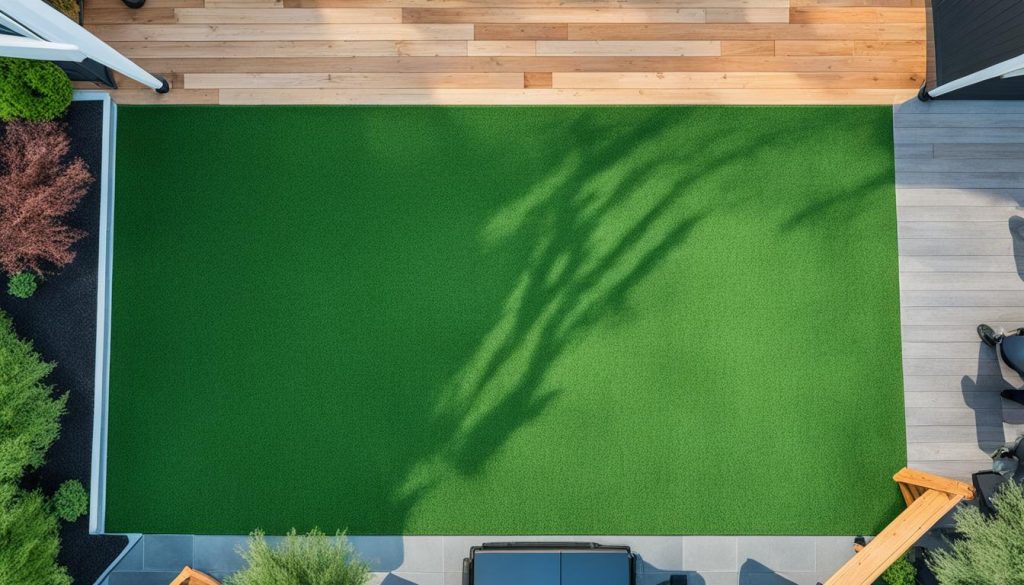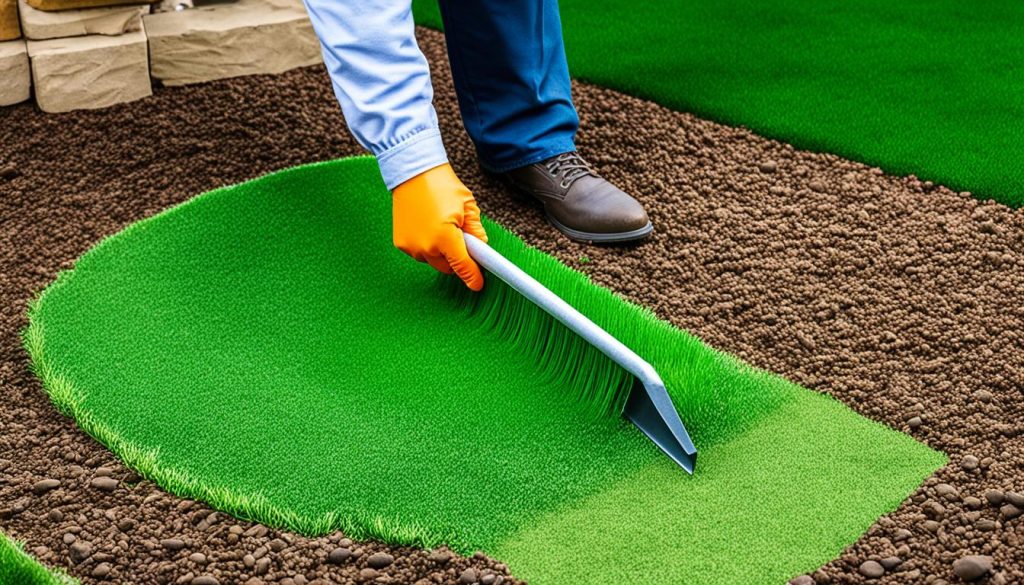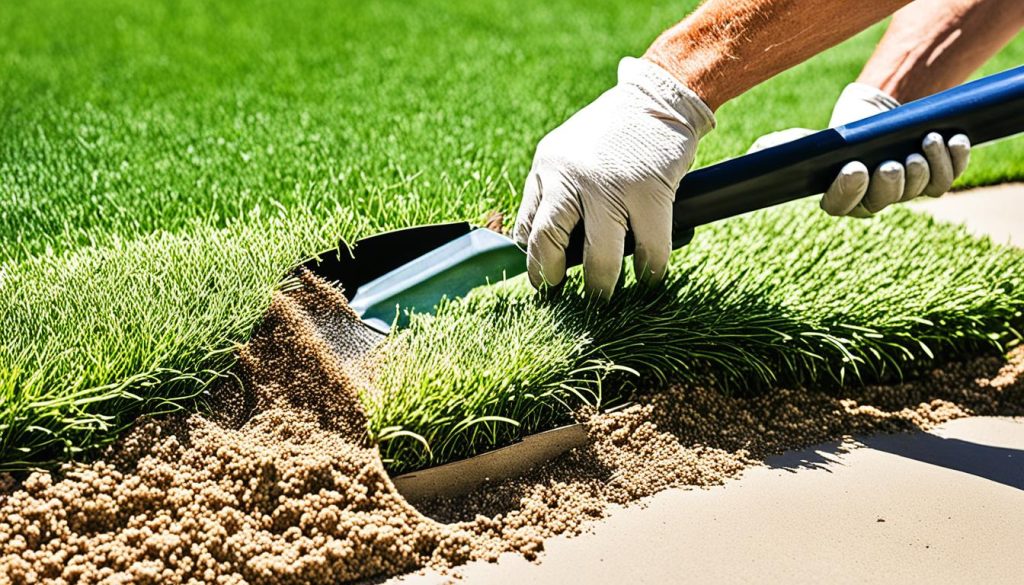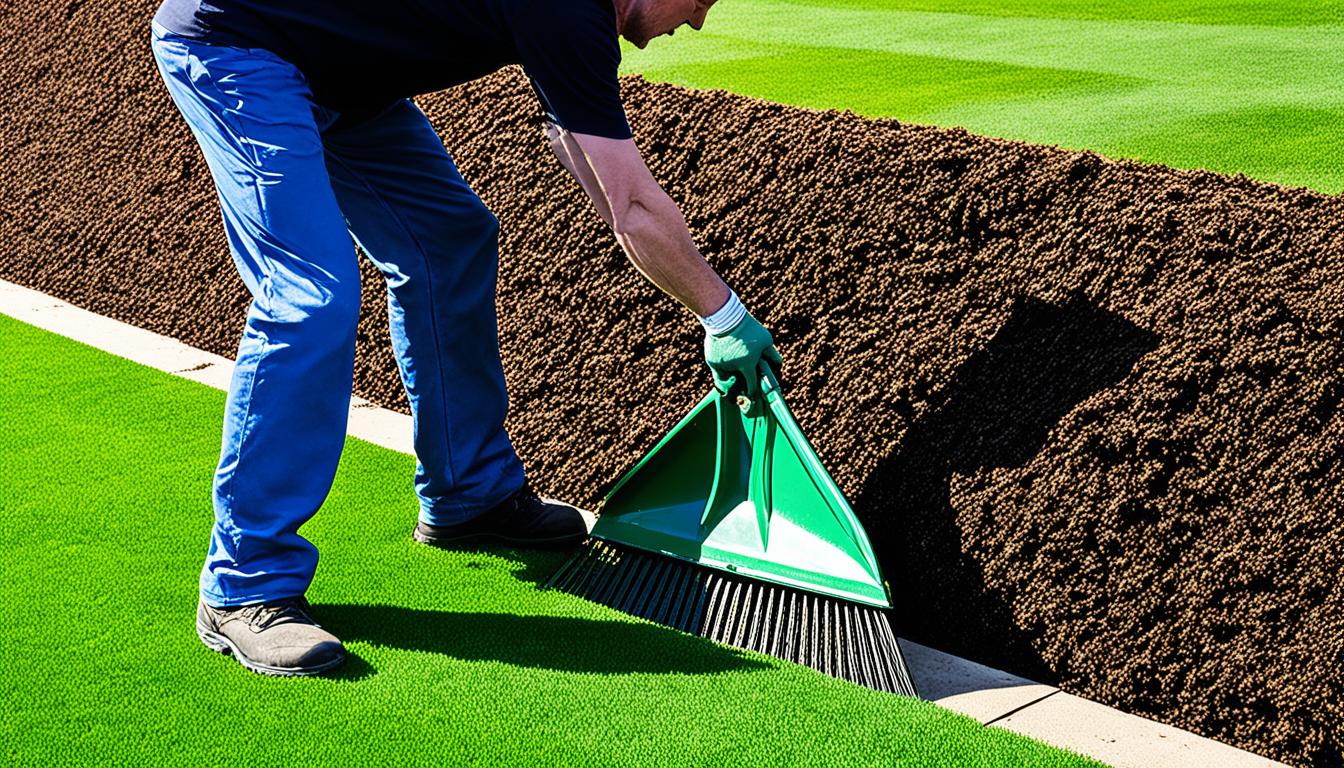Laying artificial grass can transform your outdoor space, providing a lush, green lawn all year round without the hassle of mowing and watering. Whether you’re looking to revamp your garden, create a play area for children, or enhance the look of your balcony, knowing how to lay artificial grass correctly is crucial for achieving a professional finish that will last for years to come.
In this comprehensive guide, we’ll walk you through the step-by-step process of laying artificial grass, from preparing the ground and installing the base to securing the edges and maintaining your new lawn. By following our expert tips and advice, you’ll soon be enjoying a beautiful, low-maintenance garden that looks great whatever the weather.
How to Lay Artificial Grass on Soil?
When it comes to laying artificial grass, it is important to consider the type of base you are working with. Laying artificial grass directly on soil is not recommended as soil can be easily affected by weather-induced wear and tear. To ensure a proper installation, follow these steps:
- Prepare a strong base: For laying artificial grass on soil, it is important to create a stronger base to prevent damage or unevenness. This can be done by using a combination of MOT type 1 and granite stone 6mm dust. This combination provides stability and helps to ensure a long-lasting artificial grass lawn.
- Properly compact the base: To create a smooth and even surface, it is essential to compact the base properly. This can be done using planks or a vibrating plate compactor. Proper compaction is crucial for the stability and longevity of the artificial grass.
- Apply a weed membrane: Before laying the artificial grass, it is important to apply a weed membrane. This helps to prevent weed growth and allows for proper water drainage.
- Lay the artificial grass: Once the base is prepared and the weed membrane is in place, it’s time to lay the artificial grass. Roll out the grass carefully, making sure to trim the edges to fit the desired area.
- Add finishing touches: To enhance the overall appearance of the artificial grass, consider adding kiln sand. This helps to create a natural-looking finish.
- Maintain and brush the pile: Regular maintenance is necessary to keep the artificial grass looking its best. Brushing the pile regularly helps to maintain its appearance and prevent matting.
By following these steps, you can lay artificial grass on soil and create a beautiful and low-maintenance lawn. Remember to choose high-quality artificial grass and consult local suppliers, like Homebase or Wickes, for the best products.
| Cheapest Way to Lay Artificial Grass on Soil | Pros | Cons |
|---|---|---|
| MOT type 1 and granite stone 6mm dust base | – Provides a stable foundation – Prevents wear and tear – Long-lasting |
– Requires proper compaction – Additional materials and labor costs |
| Proper maintenance and regular brushing | – Maintains appearance – Prevents matting – Low-cost option |
– Requires regular upkeep – Time-consuming |

Tips for a Successful Installation on Soil
- Ensure the soil is well-prepared and compacted before laying the artificial grass.
- Use high-quality artificial grass to ensure a long-lasting and visually appealing result.
- Consider hiring a professional installer for best results, especially for larger or more complex projects.
- Regularly brush the artificial grass to maintain its appearance and prevent matting.
How to Lay Artificial Grass on Concrete?
Artificial grass can be successfully laid on top of concrete, as long as the surface is even and properly prepared. Before laying artificial grass on concrete, it is recommended to clean the surface and ensure it can drain water correctly. Using an underlay is also advisable to provide additional protection for the artificial grass and make sure it is properly maintained. The process of laying artificial grass on concrete is similar to other installation methods, including planning and clearing the area, creating an edge, laying the base, applying weed membrane, laying the artificial grass and trimming the edges, and adding finishing touches like kiln sand. Making sure the artificial grass is properly positioned and secured is important for a neat and long-lasting result.
Step-by-Step Guide to Lay Artificial Grass on Concrete
- Start by cleaning the concrete surface and ensuring it is free from any debris or loose particles. Use a broom or blower to remove dirt and dust.
- If necessary, repair any cracks or uneven spots on the concrete surface. Fill the cracks and level the surface using a suitable concrete repair product.
- Apply a layer of underlay to the cleaned and repaired concrete surface. The underlay will provide cushioning and protection for the artificial grass.
- Lay the artificial grass on top of the underlay, starting from one corner of the concrete surface. Ensure that the grass is properly aligned and positioned.
- Trim the edges of the artificial grass to fit the shape of the concrete area using a sharp knife or scissors. Be careful not to damage the grass fibers.
- Secure the artificial grass to the concrete surface using adhesive or heavy-duty tape. Follow the manufacturer’s instructions for the specific adhesive or tape being used.
- Once the artificial grass is secured, brush the grass fibers with a stiff brush to give it a natural appearance. This will also help to distribute the infill material evenly.
- Add kiln-dried sand or rubber infill between the grass fibers to provide stability and enhance the performance of the artificial grass.
- After adding the infill, brush the grass fibers again to ensure that the infill is evenly distributed and the grass looks its best.
- Regularly maintain the artificial grass by brushing the fibers to prevent matting and to keep it looking lush and vibrant.
How to Lay Artificial Grass on Wood?
It is possible to lay artificial grass on wood, but some precautions need to be taken. The wood should be strong and fresh, without any signs of weakness or mold. Before installing artificial grass on wood decking, it is important to use an underlay and a weed membrane to ensure the longevity of the artificial grass. The process of laying artificial grass on wood is similar to other installation methods, including planning and clearing the area, creating an edge, laying the base, applying weed membrane, laying the artificial grass and trimming the edges, and adding finishing touches like kiln sand. Properly securing the artificial grass and ensuring good contact between the grass and the wood surface is crucial for a successful installation.
When laying artificial grass on wood, it is crucial to choose a strong and fresh wood surface to ensure the longevity and stability of the installation. Avoid using wood that shows signs of weakness, rot, or mold, as it can affect the performance and lifespan of the artificial grass. Additionally, apply an underlay specifically designed for artificial grass to provide cushioning and protection against any irregularities in the wood surface.
Before laying the artificial grass, it is important to clear the area of any debris or obstacles and create a defined edge using wooden planks or other suitable materials. This will help to secure the artificial grass and give it a neat and professional finish.
Next, prepare the base by laying a layer of MOT type 1 or granite stone 6mm dust on the wood surface. This will provide a stable foundation for the artificial grass and prevent it from sinking or shifting over time. Ensure the base is even and properly compacted using a compactor or a hand tamper.
Apply a weed membrane over the compacted base to prevent weed growth and ensure proper drainage. This will help to maintain the quality and appearance of the artificial grass.
Now, it’s time to lay the artificial grass on the wood surface. Start by unrolling the grass and positioning it carefully, ensuring that it covers the entire area evenly. Trim any excess grass using a sharp utility knife to achieve a clean and seamless look.
After laying the grass, secure it to the wood surface using galvanized nails or staples, making sure it is securely fastened. This will prevent the grass from shifting or moving when walked upon.
To add the finishing touches, spread a layer of kiln sand over the surface of the artificial grass and use a stiff brush to distribute it evenly. This will give the grass a natural and realistic appearance.
Regular maintenance is essential to keep your artificial grass looking its best. Brush the pile regularly to prevent it from flattening and to maintain its shape and aesthetics. Additionally, remove any debris or leaves that may accumulate on the surface.

Pros and Cons of Laying Artificial Grass on Wood
| Pros | Cons |
|---|---|
| Ability to transform wood decking into a low-maintenance lawn | Requires proper preparation and maintenance |
| Can enhance the visual appeal of outdoor spaces | Wood must be strong and free from weakness or mold |
| No need for regular mowing, watering, or fertilizing | May be more expensive compared to natural grass |
| Durable and long-lasting | May not provide the same cooling effect as natural grass |
| Requires minimal maintenance and upkeep | May not be suitable for heavy foot traffic areas |
How to Lay Artificial Grass on Sand or Stones?
Artificial grass can be laid on both sand and stones. When laying artificial grass on sand, a depth of around 20mm is recommended. The sand should be evenly spread and compacted to provide a stable base for the artificial grass. Laying artificial grass on stones follows a similar process, ensuring the stones are even and properly compacted. It is important to apply a weed membrane to prevent weed growth and ensure proper water drainage. The rest of the installation process, including laying the artificial grass, trimming the edges, and adding finishing touches, remains the same.

| Laying Artificial Grass on Sand | Laying Artificial Grass on Stones |
|---|---|
|
|
How to Lay Artificial Grass on an Existing Lawn?
Transforming an existing lawn with artificial grass is a straightforward process that requires proper preparation and installation techniques. By following the step-by-step guide below, you can achieve a beautiful and low-maintenance artificial grass lawn.
1. Remove the Existing Turf
Begin by removing the existing turf to a depth of around 2 inches. This can be done using a turf cutter or a spade. Ensure that the surface is clear of any debris or vegetation.
2. Create an Edge
Create an edge around the lawn area to define the boundaries of your artificial grass. This can be achieved by using wooden stakes and flexible edging. Make sure the edge is firmly in place.
3. Lay the Base
Next, lay a base consisting of MOT type 1 or granite dust. This will provide a stable foundation for your artificial grass. Spread the base evenly and compact it using a plate compactor or a vibrating roller. This will ensure a smooth and level surface.
4. Apply a Weed Membrane
To prevent weed growth, it is important to lay a weed membrane over the prepared base. This will also help with water drainage. Make sure the membrane covers the entire lawn area and overlaps at the edges.
5. Lay the Artificial Grass
Now it’s time to lay the artificial grass. Roll out the grass over the prepared area, leaving excess material at the edges. Trim the grass to fit the lawn area, leaving a small gap for expansion during hot weather. Secure the edges using galvanized nails or staples.
6. Trim the Edges
Using a sharp utility knife, carefully trim the edges of the artificial grass to create a clean and tidy finish. Remove any excess material.
7. Add Finishing Touches
To improve the overall look and feel of your artificial grass lawn, consider applying kiln-dried sand between the grass blades. This will help stabilize the grass and give it a more natural appearance. Brush the grass with a stiff broom to evenly distribute the sand.
8. Regular Maintenance
Maintaining your artificial grass lawn is easy. Regularly brush the grass to keep the blades upright and remove any debris. Additionally, check for any signs of wear or damage and address them promptly to ensure the longevity of your artificial grass.

| Step | Description |
|---|---|
| 1 | Remove the existing turf to a depth of around 2 inches. |
| 2 | Create an edge to define the boundaries of the artificial grass lawn. |
| 3 | Lay a base of MOT type 1 or granite dust and compact it. |
| 4 | Apply a weed membrane to prevent weed growth. |
| 5 | Roll out the artificial grass and trim it to fit the lawn area. |
| 6 | Trim the edges of the artificial grass for a clean finish. |
| 7 | Add kiln-dried sand between the grass blades for stability and a natural look. |
| 8 | Regularly maintain the artificial grass by brushing and addressing any wear or damage. |
Conclusion
Laying artificial grass can transform your outdoor space into a visually appealing and low-maintenance area. While hiring a professional installer is recommended for the best results, it is possible to install artificial grass yourself with the right tools and materials. Following a step-by-step installation guide is crucial for a successful installation.
Properly preparing the base, whether it’s soil, concrete, wood, sand, stones, or an existing lawn, is essential to ensure a stable foundation for the artificial grass. Applying a weed membrane, trimming the edges, and adding finishing touches, such as kiln sand, contribute to a neat and natural-looking result. Regular maintenance, like brushing the pile, will help keep your artificial grass in optimal condition.
With the availability of artificial grass products from reputable suppliers like Homebase and Wickes, installing artificial grass has become more accessible for homeowners across the UK. Whether you choose to install it yourself or hire a professional, you can achieve a beautiful and low-maintenance lawn that enhances your outdoor space.

